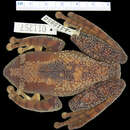Description
provided by AmphibiaWeb articles
M 69-75 mm, F 67 mm. Hand and foot with webbing. No spines on elbow and heel. Dorsal skin smooth in females but in males the dorsal surface is covered by whitish tubercles with keratinized spines, and by glands in many body regions. Males also have distinct keratinized nuptial pads. Specimens from Andohahela have a brown dorsal colour with orange and olive-greenish markings.Taken with permission from Glaw and Vences (2007).
Cadle, J., Nussbaum, R., and Andreone, F. (2008). Boophis periegetes. In: IUCN 2008. 2008 IUCN Red List of Threatened Species. www.iucnredlist.org. Downloaded on 15 March 2009.
- author
- Miguel Vences
- author
- Frank Glaw
Distribution and Habitat
provided by AmphibiaWeb articles
Andohahela, Ranomafana (Ambolovaventy, Andranaroa river, Ivalohoaka, Maharira forest) (Glaw et al. 2007). It occurs between 800-1,100 m asl (Cadle et al. 2008).
- author
- Miguel Vences
- author
- Frank Glaw
Life History, Abundance, Activity, and Special Behaviors
provided by AmphibiaWeb articles
Habits: The type specimens from Ranomafana were collected along a small, slow-moving stream in rainforest, one of the males being found at a perch height of 4-5 m. At Andohahela males called along a tiny slow-moving stream in rainforest from the vegetation ca. 3 m high. Calls: At Andohahela, the recorded calls were melodious whistles, totally different from all other calls in the B. goudoti group, except perhaps B. sp. aff. brachychir.
- author
- Miguel Vences
- author
- Frank Glaw
Life History, Abundance, Activity, and Special Behaviors
provided by AmphibiaWeb articles
Data Deficient: uncertainties related to extent of occurrence, status and ecological requirements. It occurs in Parc National de Ranomafana, and possibly also in Parc National d'Andohahela and Parc National d'Andringitra (Cadle et al. 2008).
- author
- Miguel Vences
- author
- Frank Glaw
Boophis periegetes: Brief Summary
provided by wikipedia EN
Boophis periegetes is a species of frogs in the family Mantellidae.
It is endemic to Madagascar, officially known only from Ranomafana National Park with unconfirmed records in Andohahela National Park, Andringitra National Park and Kalambatritra Reserve. Its natural habitats are subtropical or tropical moist lowland forests, subtropical or tropical moist montane forests, and rivers. It is threatened by habitat loss for agriculture, timber extraction, charcoal manufacturing, invasive eucalyptus, livestock grazing and expanding human settlement.
- license
- cc-by-sa-3.0
- copyright
- Wikipedia authors and editors

